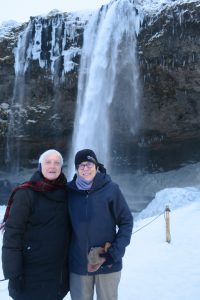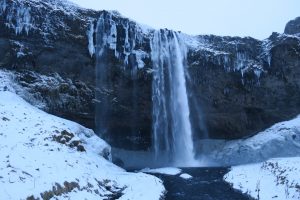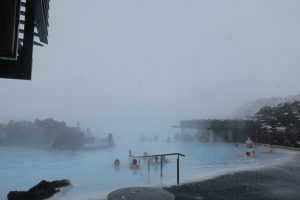It was snowing lightly this morning. At breakfast we learned that a couple of people went out last night to look for the northern light but there wasn’t much to see and it was very cold and windy so we didn’t miss much.
Seljalandsfoss waterfall was our first stop. In the warmer weather you can walk behind the falls but it was too icy this time of year. The falls are 210 ft high and the water originates from the Eyjafjallajökull glacier, which caps the volcano that erupted in 2010.
We had a 2 hour ride to the Blue Lagoon, during which Helga provided some more background information on Iceland.
-
- Overall Iceland tends to be a good place to live and a good place to bring up kids. Many people go abroad for graduate education but they tend to return to Iceland. Not surprisingly, people tend to stay inside in December and January and be outside most of the summer.
- Iceland has just one breed of horse, the Icelandic horse. They tend to be small, strong, and docile. No horse have been brought to the island since the 10th century so all of the horses today descend from the ponies originally brought to Iceland in the Settlement Age. Sometimes horses are sent to other countries for competition but they don’t come back because the returning horse could bring back disease which could infect the local horse population. Today the horses are used only for recreation but in early times they were a critical form of transportation.
- Kids can start school at age 2. It’s mandatory from 6-16 and these grades are free. School fees for the nonmandatory grades are minimal, for example college tuition at a public university is about $700/year. Many people go abroad for graduate school. Kids start learning english in the 3rd grade and continue to learn it for 7 years. They are also exposed to it on TV and at movies which are mostly in english with Icelandic subtitles. They also learn Danish. The children have weekly swimming lessons in school and must pass a swimming test to graduate from high school. The school year runs from the end of August until the beginning of June. Rents are high so kids tend to live with their parents longer after they graduate.
- The unemployment rate is close to 4%, the highest it’s been in several years. New employees start with 4 weeks of vacation and eventually it increases to 6 weeks. Maternity leave is 12 months and the mother typically takes off 9 months and the father typically takes off 3 months.
- There are many taxes including sales tax, income tax, county tax, property tax, and inheritance tax. The tax rates are as follows 32% up to a monthly salary of $3000, 37% on monthly salaries between $3000 and $9000 and 46% for monthly salaries above $9000. Icelanders pay into a mandatory pension fund and employers match the employees’ contribution. Many people pay into optional supplemental pension funds.
- Health care is socialized. There is one main hospital in Reykjavik that services the whole country with clinics in the outer regions. If you are admitted to the hospital you don’t pay anything but there are minimal charges for outpatient procedures and testing. For example an x-ray cost around $150. There is a waiting list for some non-life threating procedures. All kids have full medical and dental coverage.
- They have Costo, Ikea, and H&M as well as many fast food chains but no McDonalds, Starbucks, Burger King, or Wendy’s. Gas cost about $9/gallon.
- About 20% of power is generated geothermally. Geothermal power is created by drilling into the ground until they reach superheated water (400F). The geothermal plants are, by definition, built in volcanically active areas so they are vulnerable to volcanic eruptions. The pressure of the water coming out of the ground turns turbines which generates the electricity. The other 80% is hydro generated by Iceland’s two rivers and 80% of the hydro is used for heavy industry, such as aluminum smelting because it is quite cheap.
- The government dictates a list of first names that people can use to name their kids. These names fit all the rules of grammar (not sure which rules those are). Last names are based on the father’s last name with son or dottir appended on the end. In addition to this last name some people use a family name from their mother’s side. Icelanders call each other by their first names. Their language does not have the terms Mr. or Mrs.
- The sagas are epic stories that were probably told in settlement era and were written in the 13th and 14th centuries. All Icelanders know the sagas.
- There are a couple of unique Christmas folklore stories. This summary is from Wikipedia . . . Icelandic Christmas folklore depicts mountain-dwelling characters and monsters who come to town during Christmas. The stories are directed at children and are used to scare them into good behaviour. The folklore includes both mischievous pranksters who leave gifts during the night and monsters who eat disobedient children.
The figures are depicted as living together as a family in a cave and include:
-
-
- Gryla and Leppaludi – Gryla is a giantess with an appetite for the flesh of mischievous children, who she cooks in a large pot. Her husband, Leppaludi, is lazy and mostly stays at home in their cave.
- The Yule Cat is a huge and vicious cat who lurks about the snowy countryside during Christmas time and eats people who have not received any new clothes to wear before Christmas Eve.
- The Yule Lads are the sons of Gryla and Leppaludi. They are a group of 13 mischievous pranksters who steal from or harass the population and all have descriptive names that convey their favorite way of harassing. They come to town one by one during the last 13 nights before Christmas. They leave small gifts in shoes that children have placed on window sills, but if the child has been disobedient they instead leave a potato in the shoe.
-
We had lunch in Grindavik and then went to the blue lagoon. The blue lagoon is the result of geothermal water pumped into a lava field. The silica from the geothermal water plugged the holes in the lava rock and prevented the water from draining. The water’s milky blue shade is due to its high silica content. The silica forms soft white mud on the bottom of the lake which bathers rub on themselves.The water is also rich in salts and algae. The water temperature in the bathing and swimming area of the lagoon averages 99–102 °F.
Shortly after the opening of the geothermal power plant in 1976, the runoff water had made pools. In 1981, a psoriasis patient bathed in the water and noted that the water alleviated his symptoms and the lagoon subsequently became popular. Bathing facilities opened in 1987 and in 1992 the Blue Lagoon company was established. Studies made in the ’90s confirmed that the lagoon had a beneficial effect on the skin disease psoriasis.
We went into the changing rooms and showered before going into the lagoon. The lagoon was nice and warm and the water was about up to my neck. It was fun to have the snow landing on our face but our bodies were nice and warm in the lagoon. Very relaxing experience. We got a silica mask and a drink. I spent about 1/2 hour in the lagoon and then got out showered and went to find mom. I couldn’t take my camera into the lagoon so here is a picture from the deck.
We continued on to Reykjavik and got checked into the hotel. That evening we had our farewell dinner at a local restaurant.




Impressed you went to Iceland in the middle of winter! We did an Icelandic Air package which provided air/car/hotels and took us around the entire island (independently). Loved it. Traveled in late September several years ago. Not sure I’d do the same at this time of year, although would have been great to see the amazing Northern Lights (maybe a flicker here and there). Did enjoy the Blue Lagoon! As always, loved your pics and narrative.